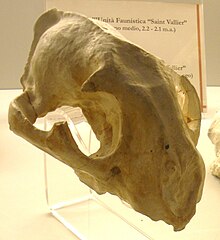| Puma pardoides Temporal range: Pliocene-Pleistocene PreꞒ Ꞓ O S D C P T J K Pg N | |
|---|---|

| |
| Skull | |

| |
| Scientific classification | |
| Domain: | Eukaryota |
| Kingdom: | Animalia |
| Phylum: | Chordata |
| Class: | Mammalia |
| Order: | Carnivora |
| Suborder: | Feliformia |
| Family: | Felidae |
| Subfamily: | Felinae |
| Genus: | Puma |
| Species: | †P. pardoides |
| Binomial name | |
| †Puma pardoides (Owen, 1846) | |
| Synonyms | |
| |
Puma pardoides is an extinct prehistoric cat in the genus Puma known from fossils found across Eurasia.
History and naming
Puma pardoides was originally described in 1846 as Felis pardoides. A complete skull was described in 1954 as Panthera schaubi, but was assigned in 1965 to a new genus as Viretailurus schaubi due to distinct differences from other pantherine cats. In 2001, however, it was pointed out that the various puma-like fossils in Eurasia could all be attributed to a single species, Puma pardoides. And in 2004, Viretailurus schaubia was also found to be a junior synonym of Puma pardoides.
Classification
Panthera schaubi or Viretailurus schaubi was historically often regarded as a basal member of the genus Panthera. However, research in 2004 concluded that Viretailurus should actually be included in the genus Puma as a junior synonym of Puma pardoides. Fossils of this leopard-sized animal are around 2 million years old and were found in France. However, their classification was difficult, due to the similarities between leopards and pumas, until teeth found at the Upper Pliocene Transcaucasian site of Kvabebi were found to be similar to those of pumas. It is inferred that the species, Puma pardoides is related to living pumas, which can be supported by Eurasian origin of the puma lineage.
Extinction
The last occurrences of Puma pardoides are from about 0.85 Ma. The extinction of this felid may have had something to do with the Mid-Pleistocene Transition.
References
- Owen, Richard (1846). A History of British Fossil Mammals, and Birds. London: John Van Voorst. OCLC 4425335.
- Viret, J. (1954). "Le loess à bancs durcis de Saint-Vallier (Drôme) et sa faune de mammifères villafranchiens". Nouvelles archives du Muséum d'histoire naturelle de Lyon. 4: 1–200.
- Hemmer, H. (1964). "Studien an "Panthera schaubi" Viret aus dem Villafranchien von Saint-Vallier (Drôme)". Neues Jahrbuch für Geologie und Paläontologie, Abhandlungen. 122: 324–336.
- Hemmer, H. (2001). "Die Feliden aus dem Epivillafranchium von Untermassfeld". In Kahlke, R. D. (ed.). Das Pleistozän von Untermassfeld bei Meiningen (Thüringen). Bonn: Römisch-Germaisches Zentralmuseum. pp. 699–782.
- Cherin, Marco; Iurino, Dawid A.; Sardella, Raffaele (2013). "Earliest occurrence of Puma pardoides (Owen, 1846) (Carnivora, Felidae) at the Plio/Pleistocene transition in western Europe: New evidence from the Middle Villafranchian assemblage of Montopoli, Italy". Comptes Rendus Palevol. 12 (3): 165–171. Bibcode:2013CRPal..12..165C. doi:10.1016/j.crpv.2013.01.002.
- ^ Hemmer, H.; Kahlike, R. D.; Vekua, A. K. (2004). "The Old World puma Puma pardoides (Owen, 1846) (Carnivora: Felidae) in the Lower Villafranchian (Upper Pliocene) of Kvabebi (East Georgia, Transcaucasia) and its evolutionary and biogeographical significance". Neues Jahrbuch für Geologie und Paläontologie, Abhandlungen. 233: 197–233. doi:10.1127/njgpa/233/2004/197.
- Turner, Alan; Anton, Mauricio (1997). The Big Cats and Their Fossil Relatives. Columbia University Press. ISBN 0-231-10229-1.
- "Pumas of South Africa, cheetahs of France, jaguars of England". Tetrapod Zoology.
- Madurell-Malapeira, Joan (2010). "The Iberian record of the puma-like cat Puma pardoides".
{{cite journal}}: Cite journal requires|journal=(help) - Palombo, Maria Rita (19 May 2016). "LARGE MAMMALS FAUNAL DYNAMICS IN SOUTHWESTERN EUROPE DURING THE LATE EARLY PLEISTOCENE: IMPLICATIONS FOR THE BIOCHRONOLOGICAL ASSESSMENT AND CORRELATION OF MAMMALIAN FAUNAS". Alpine and Mediterranean Quaternary. 29 (2): 143–168. Retrieved 25 February 2024.
| Taxon identifiers | |
|---|---|
| Felis pardoides | |
This felid-related article is a stub. You can help Misplaced Pages by expanding it. |
This article related to prehistoric animals from order Carnivora is a stub. You can help Misplaced Pages by expanding it. |